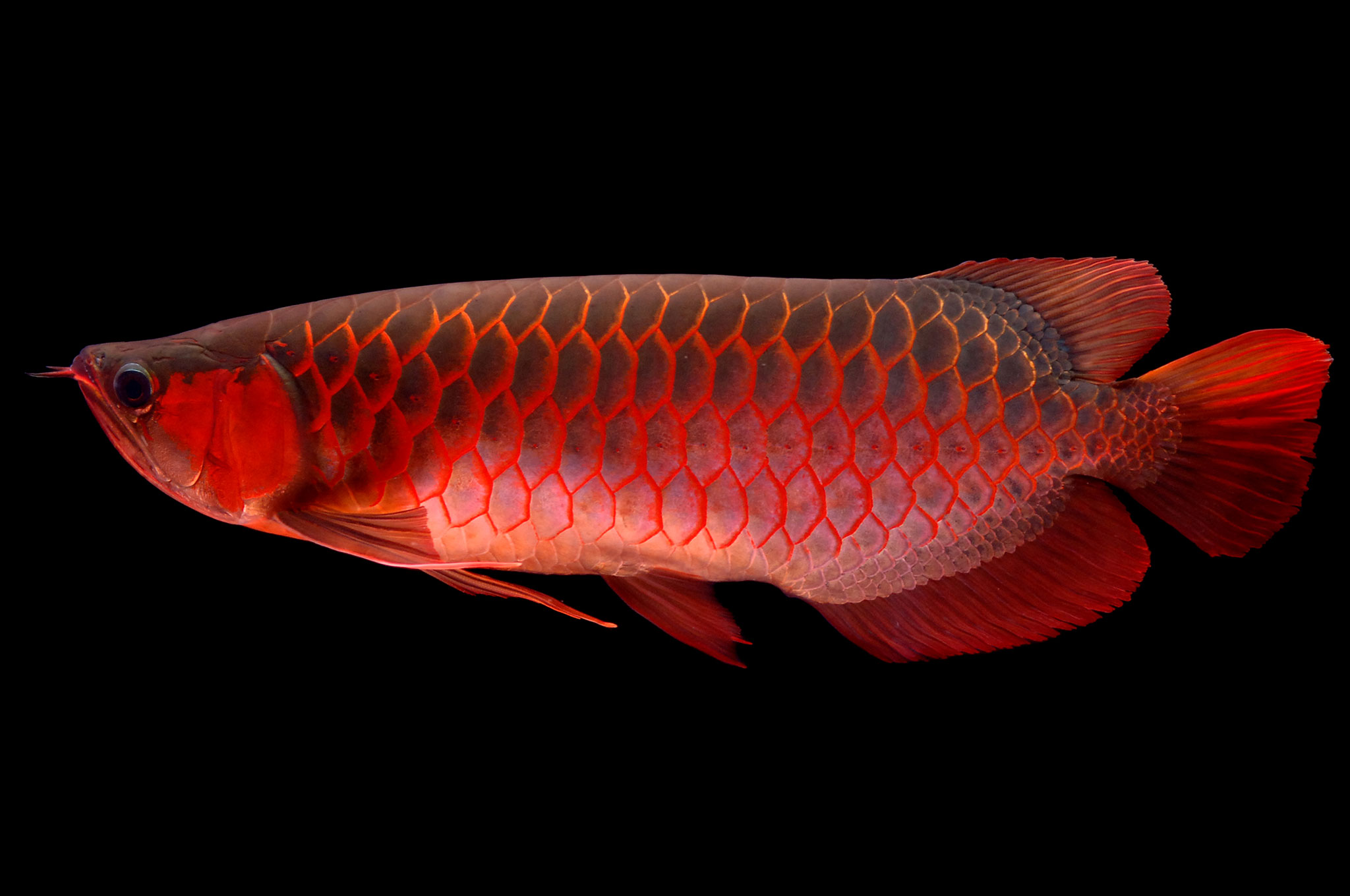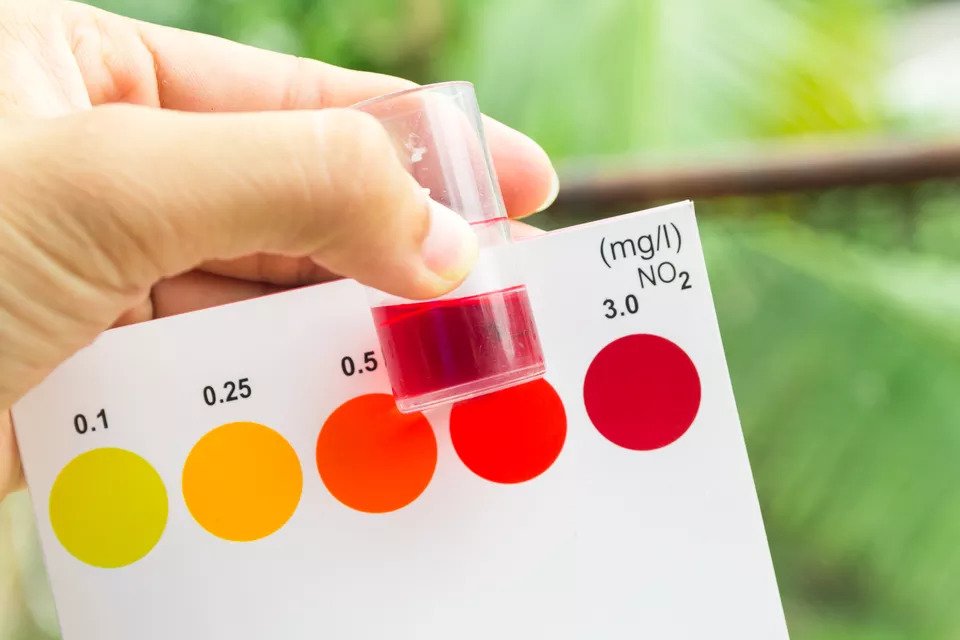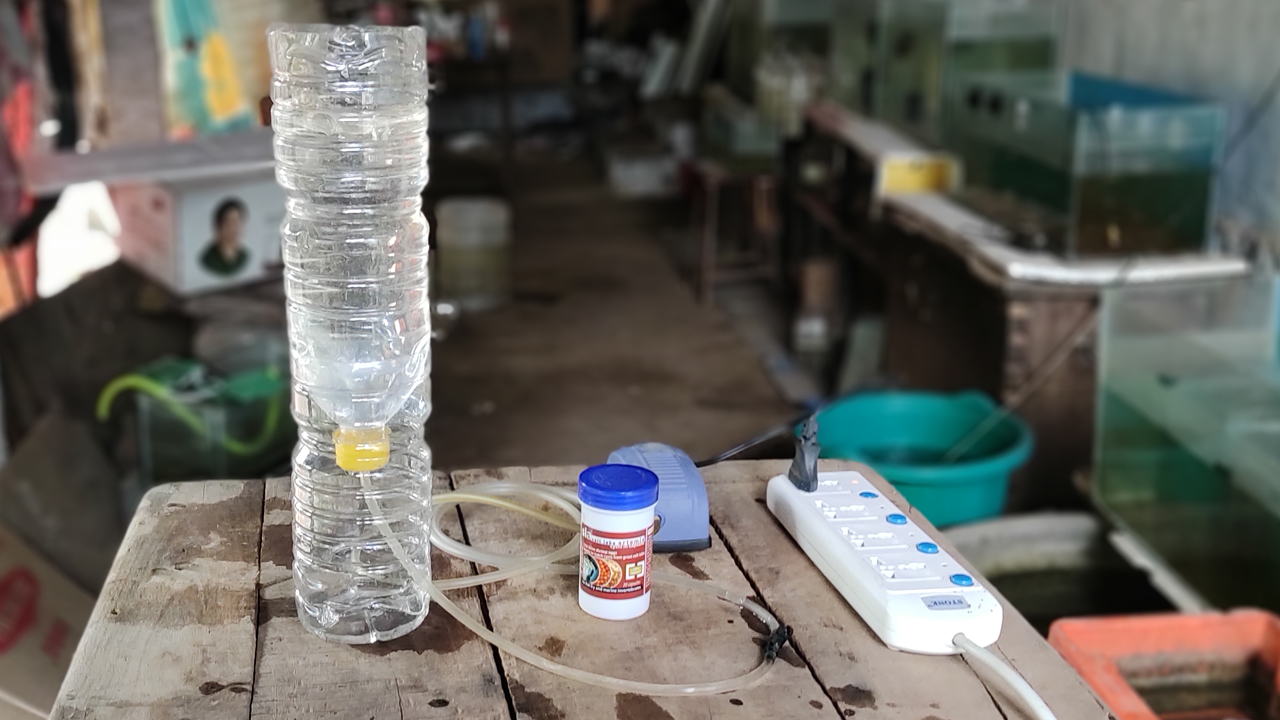கப்பீஸ் பிரீட் செய்வது எப்படி

நீங்கள் இனப்பெருக்கம் செய்ய விரும்பும் மீனைத் தேர்ந்தெடுக்கவும். நீங்கள் இனப்பெருக்கம் செய்ய விரும்பும் மீன்களின் எண்ணிக்கை, ஒவ்வொரு மீனின் வண்ணம் மற்றும் அவற்றின் வால்களின் வடிவம் ஆகியவற்றை நினைவில் கொள்ளுங்கள். ஒரே வண்ண வடிவங்களைக் கொண்ட இனப்பெருக்கத்திற்கு நீங்கள் இரண்டு மீன்களைத் தேர்வுசெய்தால், குட்டிகள் அந்த வண்ண வடிவத்தைக் கொண்டிருக்கும். அதே கொள்கை துடுப்பு வடிவத்திற்கும் பொருந்தும்.
1. மீன்களின் எண்ணிக்கை: பொதுவாக, நீங்கள் இனப்பெருக்கம் செய்ய ஒரு ஆண் மற்றும் இரண்டு அல்லது மூன்று பெண் கப்பிகளை தேர்ந்தெடுக்க விரும்புவீர்கள். ஒன்றுக்கு ஒன்று என்ற விகிதம் இருக்கும்போது, ஆண் பெரும்பாலும் ஆக்ரோஷமாகி, தொட்டியைச் சுற்றி பெண்ணைத் துரத்துகிறான். ஒன்று முதல் மூன்று விகிதத்தில், ஆணின் கவனம் மூன்று பெண்களுக்கு இடையில் பிரிக்கப்பட்டு, இனப்பெருக்கம் பெண்களுக்கு குறைந்த மன அழுத்தத்தை ஏற்படுத்தும்.
2. வண்ண முறை: பல அடிப்படை குப்பி வடிவங்கள் உள்ளன. காட்டு (சாம்பல் அல்லது ஆலிவ் வண்ணம்), அல்பினோ (வெளிர் நிறங்கள் அல்லது சிவப்பு கண்களால் வெள்ளை,) பொன்னிறம் (கருப்பு நிறமியுடன் ஒளி வண்ணங்கள்,) மற்றும் நீலம் (பளபளக்கும் நீல நிறம்.)
3. வால் வடிவம்: குப்பி வால்களின் வடிவம் வட்டமான பின்புற துடுப்பிலிருந்து வாள் போன்ற வடிவம் வரை இருக்கும். குப்பி வால்கள் வரும் பல்வேறு வடிவங்கள் மற்றும் அளவுகள் உள்ளன, ஆனால் மிகவும் பொதுவானவை டெல்டா (இது ஒரு பெரிய முக்கோண வடிவம்,) ஃபேன்டெயில் (இது விசிறி போல வடிவமைக்கப்பட்டுள்ளது) மற்றும் வட்ட வால் (இது ஒரு சிறியது, வட்ட வடிவம்.

இனப்பெருக்க தொட்டியைத் தேர்ந்தெடுக்கவும். நீங்கள் ஒரு ஹீட்டர் மற்றும் மென்மையான வடிகட்டியுடன் 10 முதல் 20 கேலன் தொட்டியைத் தேர்ந்தெடுக்க வேண்டும். வடிகட்டி மென்மையாக இருக்க வேண்டும் என்று நீங்கள் விரும்புகிறீர்கள், இல்லையெனில் குழந்தை கப்பிகள் (அவை குட்டிகள்அழைக்கப்படுகின்றன) வடிகட்டியை உறிஞ்சி கொல்லப்படலாம். உங்கள் வடிகட்டி மிகவும் வலிமையானது என்று நீங்கள் நினைத்தால், வடிகட்டியின் திறப்பை சுத்த டைட்ஸுடன் மூடி வைக்கவும். டைட்ஸ் தண்ணீரை வடிகட்ட அனுமதிக்கும், ஆனால் குட்டிகள் பாதுகாக்கும்.

தொட்டியை அமைக்கவும். துரதிர்ஷ்டவசமாக, குப்பி பெற்றோர்கள் நரமாமிசமாக மாறலாம், எனவே அவர்கள் பிறந்த பிறகு மறைத்து வைக்கும் இடங்களை குட்டிகள் வழங்க வேண்டும். கப்பி குட்டிகள் மூழ்கும், எனவே அவற்றின் அட்டையில் குறைந்த மிதக்கும் தாவரங்களைப் பயன்படுத்துங்கள். ஆரோக்கியமான குட்டிகள் மேல்நோக்கி நீந்துவதால் சில உயர் கவர் தேவைப்படுகிறது.
எந்த அடி மூலக்கூறையும் பயன்படுத்த வேண்டாம். மீன் தொட்டிகளின் அடிப்பகுதியை மறைக்கப் பயன்படுத்தப்படும் பாறைகள் / சாயல் பாறைகள் அடி மூலக்கூறு. வெற்று கீழே தொட்டி குட்டிகள் நல்லது, ஏனெனில் அது எளிதில் சுத்தம் செய்யப்படுகிறது, மேலும் எத்தனை வறுவல்கள் உயிருடன் இருக்கின்றன அல்லது அவை எவ்வளவு சாப்பிடுகின்றன என்பதை நீங்கள் பதிவு செய்யலாம்.
ஜாவா பாசி அல்லது முட்டையிடும் பாசி குப்பி குட்டிகள் ஒரு நல்ல மறைவிடத்தை வழங்குகிறது.
உங்கள் மீனின் தேவைகளுக்கு தொட்டியை சரிசெய்யவும். பெண்களும் ஆணும் ஒன்றாக தொட்டியில் இருக்கும்போது வெப்பநிலையை சுமார் 77-79 டிகிரி பாரன்ஹீட் (25 முதல் 26.11 சி) வரை அமைக்கவும். நீங்கள் இனப்பெருக்கம் தொட்டியில் கப்பிகளை வைப்பதற்கு முன், ஆரோக்கியமான இனப்பெருக்கத்தை மேம்படுத்துவதற்காக அதிக ஊட்டச்சத்து மதிப்புள்ள உணவை வாங்கவும்.

கப்பிகளை இனப்பெருக்க தொட்டியில் வைக்கவும். இந்த கட்டத்தில், நீங்கள் செய்யக்கூடியது உங்கள் மீன் இனப்பெருக்கம் செய்யக் காத்திருங்கள். உங்கள் பெண் (கள்) கர்ப்பமாக இருப்பதை நீங்கள் கவனிக்கும்போது ஆண்களை வழக்கமான தொட்டியில் வைக்கவும். ஒரு பெண் மீன் கர்ப்பமாக இருக்கிறதா இல்லையா என்பதை அவளது வயிற்றில் கருமையான குறி இருக்கிறதா என்று பார்க்கலாம். இந்த குறி ஒரு ஈர்ப்பு இடமாக அழைக்கப்படுகிறது. அனைத்து பெண் மீன்களும் கர்ப்பமாக இருக்கும்போது இதை உருவாக்கும், ஆனால் முட்டைகள் கருவுற்றிருக்கும் போது இது இருண்டதாகிவிடும்
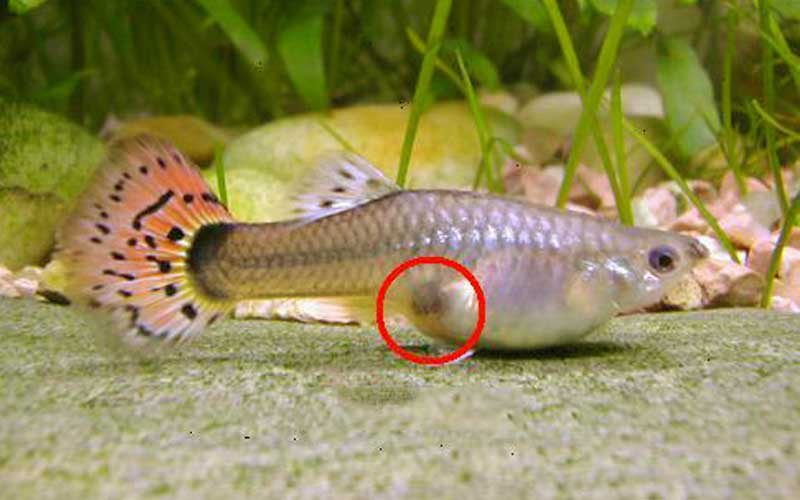
உங்கள் மீன் எப்போது பிறக்கப் போகிறது என்பதை அறிந்து கொள்ளுங்கள். பொதுவாக, கர்ப்ப காலம் 26 முதல் 31 நாட்கள் ஆகும். உங்கள் பெண் குப்பி பிறக்கத் தயாராக இருக்கும்போது, அவளது வயிறு மிகப் பெரியதாக இருக்கும், அவளது ஈர்ப்பு இடம் ஆழமான கறுப்பாக இருக்கும் (அல்லது நீங்கள் அல்பினோ அல்லது மஞ்சள் நிற குப்பிகளை இனப்பெருக்கம் செய்கிறீர்கள் என்றால் இருண்ட மெரூன்.) அவளுடைய வயிறும் அட்டை பெட்டி போல சதுரமாகிவிடும் வளர்ந்து வரும் ரவுண்டரை விட. கப்பிகள் முட்டையல்ல, வாழும் குழந்தைகளைப் பெற்றெடுக்கின்றன என்பதற்கு தயாராக இருங்கள். உங்கள் கர்ப்பிணிப் பெண்ணை நீங்கள் உன்னிப்பாகக் கண்காணிக்க வேண்டும், அதனால் அவள் பெற்றெடுக்கும் போது நீங்கள் அங்கே இருப்பீர்கள், இதனால் உடனடியாக அவளை தொட்டியில் இருந்து அகற்றலாம் (அவள் குழந்தைகளை இல்லையெனில் சாப்பிடலாம்.) ஒரு மீன் பிரசவத்திற்குச் செல்வதற்கான சில அறிகுறிகள்: மிகவும் அமைதியாக இருப்பது மற்றும் தன்னை ஒதுக்கி வைப்பது, நடுக்கம் (சுருக்கங்கள்), ஹீட்டருக்கு அருகில் தொங்குதல், அல்லது பசியின்மை (சாப்பிட மறுப்பது, அல்லது அவளது உணவை வெளியே துப்புவது உட்பட).
My First Arowana
Choosing Your First Arowana
Buying an Arowana for the first time can be both exciting and yet overwhelming for the new hobbyists, as they are presented with a wealth of choices. This guide to choosing your first Arowana is written with those new to the hobby in mind . As one’s experience, knowledge and expectations grows, factors like an Arowanas potential and bloodline comes into consideration.
Enjoy the hobby and the pride that comes with owning the legendary Dragon Fish!
Before Buying
- Understand. Read up to learn as much as you can before buying your first Arowana. It will prevent you from unnecessary headaches and heartaches. Especially important is the knowledge of the Nitrogen Cycle and considering the type of filtration that you’ll be using, e.g. OF® Hydra.
- Preparation. Prepare your aquarium tank water at least 3-4 days before bringing your new Arowana back to minimize any problems caused by water quality. It is recommended to cycle your tank before adding the Arowana.
- Research. Do your research and purchase your micro-chipped Arowana only from licensed reputable Arowana farms (the local fish shops will have the Authentication Certificates from the farms).
Things to Consider
- Size. It is recommended to purchase juvenile Arowanas that are around 15-20cm (6-9 inches), as this is the best size to groom your Arowana. Of course you can purchase adult fishes if it fits your taste and budget.
- Active and Alert. Look for an Arowana that is actively swimming, full of vitality, and more responsive to you, as it will be less timid when it goes back to your home tank.
- Background Check. Try to know the history of the fish before purchasing, e.g when it arrives to the shop (would prefer to have settled in a few days before you buy it) and which country is it from (in case you have any preferences).
- Arowana Health & Condition. Make sure it fits as much to the criteria set in the checklist below.
- Diet. Check with the owner the diet that the Arowana is being fed on (e.g. live feed or pellets). And if possible, let the owner show you that the fish is eating well. Observe the fecal matter in the tank; it should be dark brown in colour and in small crumbles.
- Authentication. Once you decide to buy the fish, scan the fish for the chip and verify with the farm on the authenticity of the strains that you are buying. Click here to check the authenticity of your Qian Hu Arowana.
Arowana Health Checklist
Beauty lies in the eyes of the beholder and one person’s definition of beauty might defer with another. Hence in this checklist, we will be focusing on the signs of a healthy Arowana.

| Body Parts | Things to Look Out For |
| Scales | ❑ Arowana Scales should be shining/radiant and complete. ❑ The coloration of the scales should be even and clear. ❑ There should be no decaying scales. |
| Head | ❑ The head should be free of any holes/injuries. ❑ Ratio of its head to its body should be 1:3. |
| Mouth | ❑ The mouth should close properly with the ends of the top jaw and bottom jaw meeting. ❑ There should be no protrusions, bleeding or pus. |
| Barbel | ❑ Both barbels should be of equal length, straight and pointing upwards. ❑ Barbels should not have any granule-like particles on them. |
| Fins | ❑ All fins should be fully stretched without damages. ❑ Appears translucent without signs of blood clotting at the base. |
| Gills | ❑ The colour of the gills should be clear and fresh red. ❑ Breathing should be regular, not irregular/rapid. |
| Operculum (Gill Flap) | ❑ Operculum should be close to its body and not curled. ❑ Operculum of matured RTG and Crossbacks should appear shiny instead of dull coloured. ❑ Matured red Arowanas should have bright orangey-red, orange or red colours, etc. |
| Eyes | ❑ Both eyes should be of same sizes and full, not dented or bulging. ❑ Cornea should be bright and clear, not cloudy. |
| Vent | ❑ Its vent should be tight, not protruded/swollen or bloody red. |
How to care your Betta Fish
How to Set Up for Your Betta Fish

- Purchase an appropriate aquarium. Although you will likely purchase your fish in a small plastic or glass container, he will do much better if he has more room. Purchase a one- or two-gallon fish tank or find another container that holds at least a gallon of water. A tank under 2.5 gallons should not have a heater or a filter. Larger tanks require a heater and a filter. You will need a vacuum to clean out the tank, too.
- Choose the right location for your fish tank. Choosing a good location for your fish tank is important because the wrong location could expose your new pet to heat, drafts, or stress.
- Do not place the aquarium too close to a window because it can get too hot from the sunlight coming in or too cold if there is a draft.
- Keep the tank away from radiators or other sources of heat. Again, the tank should not get too warm.
- Choose a stable, flat surface that won’t get hit when people or other pets walk by. Placing the table or desk against a wall will add more stability and prevent too much jostling.
- Pick a location where you can sit comfortably and look at your fish. Putting your betta fish in an out-of-the-way area won’t allow you to enjoy him.
- Set up the habitat to be comfortable for your betta fish. Your fish will want to hide sometimes, so a cave or a plastic plant can provide him with a place to have some alone time. Aquarium rocks or glass marbles will help anchor the accessories in place and will also add some sparkle or color to your fish’s environment. Don’t give your betta fish a roommate, because he won’t be friendly and could end up hurting or killing another fish.
How to Feed Your Betta Fish
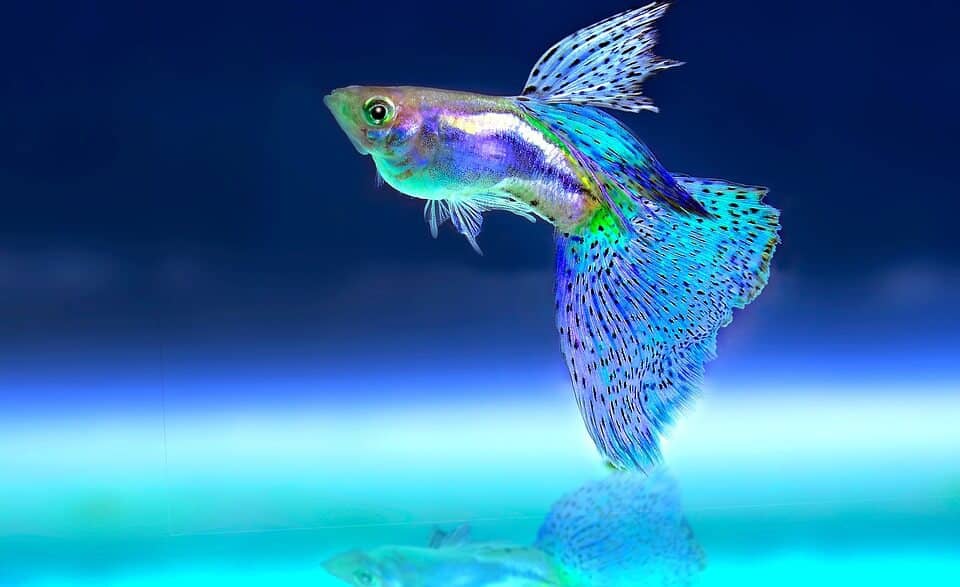
- Feed your fish the right amount of food. The amount of food that your betta fish can eat in one day is about the size of her eyeball. So take a look at your pet’s eye and give her a pinch of food that is smaller than that. Even if she eats it all in a couple of minutes, that’s enough food. If she’s not eating it all within five minutes, scoop out the excess food and feed her less next time.
- Feed your fish every day. You’ll want to feed her daily, but if you skip a day here and there, that’s okay. If you go on vacation for a week, you will certainly need to have someone come in to feed your fish every other day or so, but if you are going away from home overnight, she’ll be fine without food until you get back. Don’t feed her extra before you go or when you get back. Stick to the same amount even if you skipped a day.
- Vary your pet’s diet. Betta fish should not eat the same food every day. At least weekly, give her something that’s different from her normal diet. You can also choose two or three different foods and alternate them each day. Here are some ideas that can be found at your local pet store:
- Dried or frozen bloodworms.
- Brine shrimp.
- Fruit flies without wings or fruit fly larvae.
- Tiny pieces of frozen beef heart (this should be a rare treat).
- Avoid feeding your betta fish only pellets or dried flakes. While these are okay some of the time, they’re not a healthy diet for every single day. If you do feed dried foods, soak them first before putting them in the tank for your fish to eat.
How to Safely Move Your Betta Fish
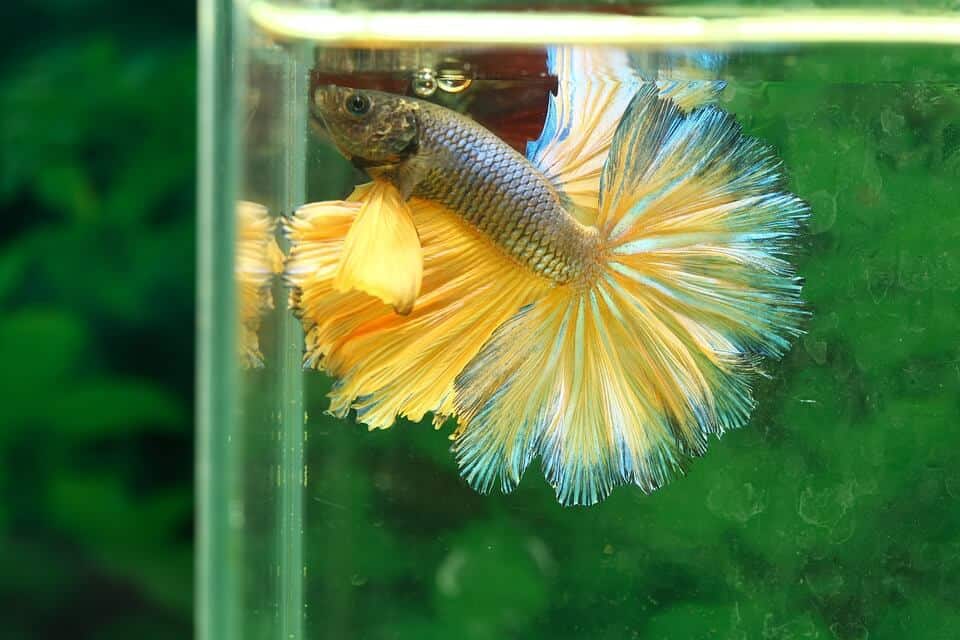
- Only pick up your fish when absolutely necessary. The only time you should be moving your fish is if you need to take him out of the tank to clean his tank or if you have to transfer him to a different tank for some reason.
- Prepare an appropriate temporary container. If you are going to clean his tank, scoop some of the dirty water out of the tank and place it in a large mug that’s dedicated to your fish or another similar container. Make sure the container is tall enough so your fish can’t jump out. To be extra safe, cover the container with a plate.
- Use a net or cup to scoop up the fish. Purchase a fish net to catch your aquatic friend. You can also try a plastic cup. Move quickly but gently to scoop him up and be careful not to pinch any part of him between the net or cup and the side of the tank.
- If your pet gets scared, try again later. If your fish starts darting around the tank trying to get away from you, wait a few minutes, then try again. He’s at a greater risk of injury if he’s trying to get away from the net. Within a few minutes, he’ll be calm enough to try again.
How to Clean Your Fish’s Aquarium
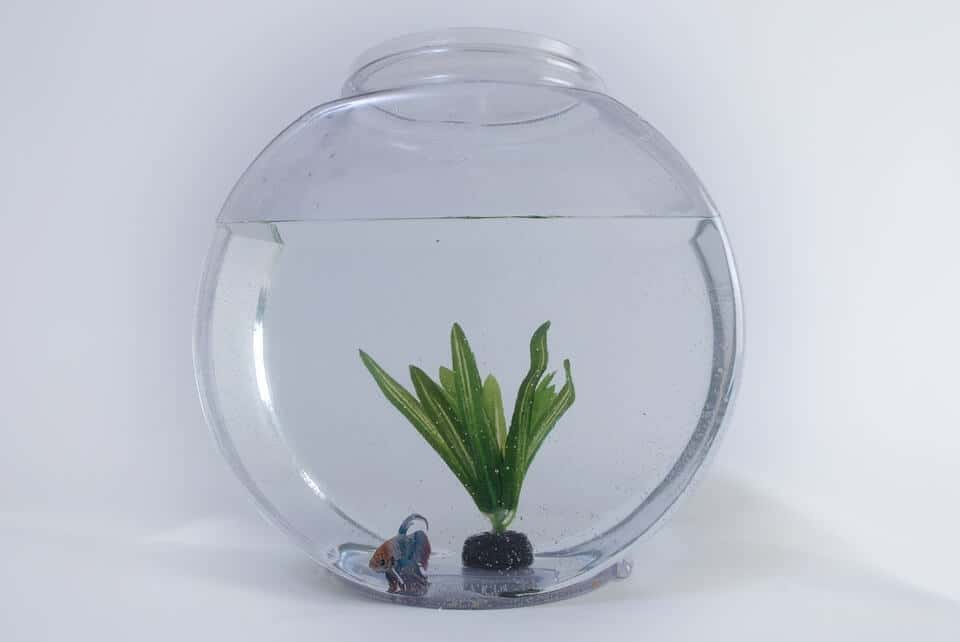
- Prepare the replacement water. The day before you are going to clean your fish’s aquarium, fill an empty water jug with tap water. Leave the top off so any chlorine that’s present in your tap water will evaporate. Keep the jug in the same area as your fish tank so the water will be the same temperature as the water in the tank. Let it sit overnight.
- Gather your supplies. You’ll need some supplies at hand so you can get the job done quickly and efficiently. They are:
- A siphon.
- A bucket.
- A sponge or algae pad. (Don’t use an old kitchen sponge; you need one that has never had detergent on it.)
- An aquarium vacuum.
- Distilled water.
- An aquarium testing kit to check for nitrates in the water.
- Determine whether you need to move your fish. If you are diligent about cleaning your fish tank each week and you don’t feed her too much, it’s likely that you will rarely have to move your fish to clean the tank. If the water is very dirty, however, it’s best to take her out for a little while. Use your fish net and be careful as described in the section above.
- Remove some of the water. For a routine cleaning, taking out approximately 20 percent of the water is sufficient. A dirty tank or one that has high nitrate levels will need about half of the water removed. Take out the water by siphoning into an empty bucket. Be careful not to siphon your fish into the bucket!
- Clean the sides of the aquarium. Use the sponge or algae pad to clean the sides of the aquarium. Don’t add any detergent or cleaner; just use the pad itself.
- Vacuum the gravel or marbles. Use your aquarium vacuum to clean up the rocks or marbles. You can push the vacuum into the bottom of the tank to stir up any sediment and waste. If the rocks are very small and might be sucked into the vacuum, just use your finger to gently stir up the rocks so the sediment floats up, then suck it up with the vacuum a half-inch or so above the rocks.
- Wash any decorations or accessories in the tank. Take out the plants, cave, and any other decorations and wash them in plain water. Don’t use detergent. Rinse them off with distilled water.
- Add new water. Once the aquarium is clean, you can carefully add the water you have prepared.
- Test the water and remedy as needed. Test the water to be sure that the nitrate level is not high. If it is, you might need to remove some of the water and add more prepared water.
How to Tell If Your Betta Fish Is Happy and Healthy
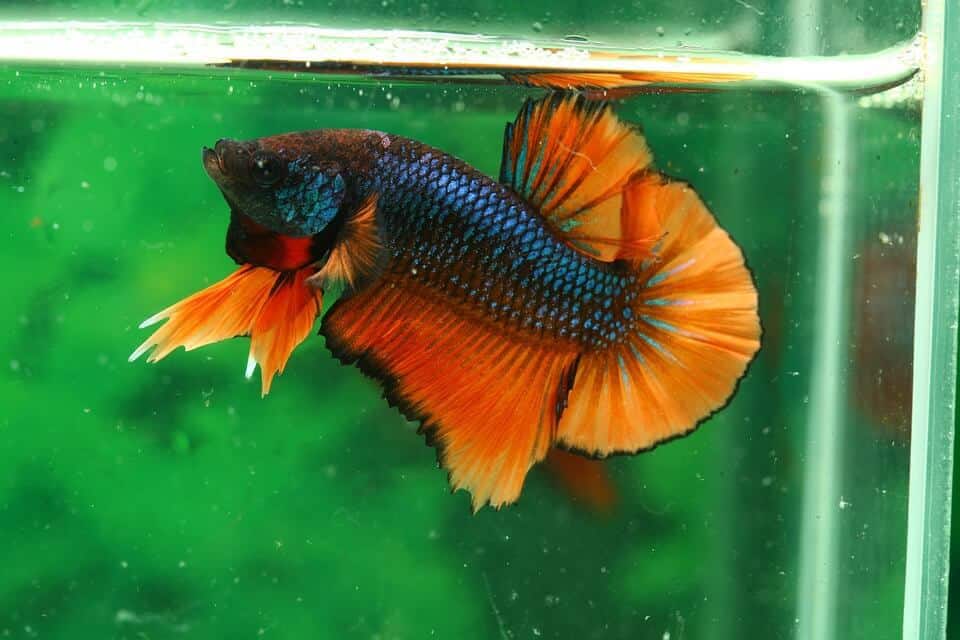
- Check your betta fish’s color. As your fish gets older or if he gets sick, his color might fade. If you notice the color fading and you have only had him a short time, it’s possible that he might be ill.
- Evaluate your betta fish’s activity level. If you wiggle your finger in front of your fish (on the outside of the tank), does he swim back and forth to interact with you? Is he swimming around in the tank near the middle or bottom? A fish who is swimming up near the top, particularly if he is putting his mouth to the top of the water, might be in distress.
- Look for bumps, torn fins, and other physical changes. Your fish shouldn’t have lumps or bumps on his body. Also, his fins and tail should remain roughly the same. If it looks like pieces of his tail or fins are coming off or tearing, that is a sign that he’s not healthy. Other signs of poor health include a white film or white dots on the fish, colored streaks that were not there before, and a swollen body. Test the water to see if the wrong pH or high ammonia levels are causing the problem.
- Take your fish to the vet if you are worried. It might sound funny to take a fish to the vet, but your veterinarian will be able to diagnose what’s wrong with your fish in many cases.
Your betta fish will probably live two to three years or longer; there are even some who have lived past the age of ten years old! With proper care, you will be able to enjoy your pet for a long while.
Seeding a New Aquarium
Seeding a new aquarium has become a popular practice. It is the process of transferring nitrifying bacteria from an established aquarium to a new aquarium. Seeding gives the new aquarium a jump start on the cycling process. Normally, it takes 4-6 weeks for the growth of beneficial bacteria to complete the nitrogen cycle in a new aquarium. It is not unusual for seeded aquariums to fully cycle in half the time it would normally take, thus allowing you to stock more fish in the new tank sooner. Seeding also helps to reduce stress on the fish and reduces or eliminates fish loss due to the startup cycle.
Where the Bacteria Live
Contrary to some reports, significant amounts of nitrifying bacteria are not present in the water itself; they are attached to surfaces in the aquarium. Therefore, transferring water from an established tank won’t do much good. Most nitrifying bacteria reside in the gravel and in filter media (ceramic rings, filter floss, sponge, etc). The bacteria also can be present in rocks, artificial plants, and other elements with porous surfaces.
Procuring Seeding Material
The challenge of acquiring seeding material is why more people don’t seed their new aquariums, but there are several options for getting your hands on some. If you have at least one aquarium running already, seeding material is easily obtained. If you don’t have another established tank, look to a few outside sources:
- Local fish stores (LFS) – Fish shops may accommodate a customer’s request for seeding material.
- Fish clubs – Any fish club worth its salt will assist a new fish owner by providing seeding material.
- Friends – If a friend has an established tank, simply ask them for some.
Transporting Seeding Material
Moving seeding material from one tank to another must be done quickly to ensure the bacteria stay alive. Before transferring seeding material, set up the new aquarium and allow it to run for a day to stabilize the temperature and water chemistry. Once that is done, get your seeding material and use it within the hour.
During transport, keep the material covered with a small amount of water from the original tank (the source of the seeding material). Do not subject it to significant temperature changes, and move it as quickly as possible. Allowing seeding material to sit for more than an hour can result in the death of the nitrifying bacteria, as they require oxygen in the water to survive. If the material is subject to extreme hot or cold, discard it and get fresh seeding material.
Seeding With Substrate
There are two options for seeding a new aquarium using substrate from an established aquarium. The first is to simply distribute the seeding substrate in an even layer on the top of the substrate in the newly set up aquarium. This option works well if the substrates are similar in color and size.
The other method uses a bag made of nylon pantyhose. You fill the toe of the hose with 1/2 to 1 cup of the substrate, then tie off the bag, cut it from the rest of the leg, and hang the whole thing in the tank. Once the tank has cycled, remove the bag and discard it (or you can use it to line the bottom of a potted plant; the substrate allows excess water to drain from the soil, and the debris from the aquarium makes good fertilizer).
Seeding With Filter Media
Filter media is an excellent seeding material. The easiest way to use this method is to place an extra filter on an established tank for a few weeks to allow nitrifying bacteria to grow on the filter media. Sponge filters are ideal for this, as they are small, inexpensive, and easy to move. Power or even canister filters can also be used.
Once the new aquarium has been set up and has run for at least a day to stabilize the temperature, the seeding filter can be moved from the established tank to the new tank. Leave the seeding filter in place until the new aquarium has fully cycled. If desired, you can leave it in place indefinitely to serve as a source of seeding material in the future. It can also be used to quickly set up a hospital tank if the need arises.
An alternate method is to use fresh filter media (ceramic rings or a sponge) designed for use in the new aquarium filter. Place the media in a mesh bag and hang it in the established tank for a couple of weeks prior to setting up the new aquarium. This will allow nitrifying bacteria to grow within the media. When the new aquarium has been filled and the filter is ready to be installed, remove the bag from the established tank and immediately place the wet media in the new filter. This will start the new biofilter with beneficial bacteria grown in the media while it was in the established aquarium.
Final Notes
When procuring seeding material from an established aquarium, be sure that there are no diseased fish in the tank. You don’t want to bring bad bacteria or parasites into your new aquarium!
Also, there are many beneficial bacteria supplements and “bacteria starters” available through pet shops that will help a new aquarium go through the nitrogen cycle faster. Adding these boosters along with the seeding material will shorten the time it takes a new aquarium to develop a mature biological filter. This will reduce the risk of getting “New Tank Syndrome,” where the fish produce toxic wastes faster than the beneficial bacteria can break them down and make the aquarium water safe for the fish.
How To Cure Fungus on Your Fish
If your fish has a white- or gray-colored growth on its mouth or body (often with a fluffy texture like cotton), it could have a fungal infection. Fungal outbreaks are often caused by stressful or poor water quality conditions and can rapidly lead to secondary diseases, so it’s important to address the problem immediately. In this article, we cover several options for treating fungus, as well as how to stop it from coming back.
When you see any symptoms of illness, the first thing we always recommend is a thorough cleaning of the aquarium. We want to make sure the fish’s environment is optimal and free of any stress factors before we start treatment. Scrub the glass so that you can easily see the fish’s condition, clean out the detritus in your filter, and use a siphon to vacuum the substrate and change the water.
Fungus is often preventable, so the next step is to find the cause of the infection. There’s no point in treating the fish if we don’t stop the source of the problem because then the fungus may come back again in full force.
What Causes Fungus in Fish?
Poor water conditions are a common cause of fungal infections. We see many betta fish with this disease because they’re often kept in tiny containers with no heater or filter. Bettas enjoy temperatures around 78 to 80°F, which means they need a heater if your room temperature is below this range. Also, it helps to house them in an aquarium that holds at least 5 gallons or more to prevent their waste from quickly fouling the water. Doing regular partial water changes and adding live plants (especially floating plants) to a fish tank helps to remove toxic waste compounds before they affect your betta’s health.
Nutrient deficiencies can be another reason why fish get fungus. Fish, like people, need a well-rounded diet to be healthy enough to fight off diseases. Feeding fish from the same jar of flakes all the time is like feeding a person only hamburgers every day. Sure, they can survive, but their bodies probably aren’t in tip top condition. Therefore, make sure to a) provide a wide assortment of foods so that they get all their essential nutrients and b) give them fresh, high-quality foods. Yes, the expiration date on the container may say the food is good for another three years, but every time you open the container, more air and moisture get inside, causing the food to become stale in a matter of months. If you don’t have enough fish to finish the jar in a short amount of time, consider splitting up the food into smaller bags and freezing them to preserve their freshness until you’re ready to use them. Finally, avoid using wet fingers to get food out of the container because this causes the food to become moldy, which can result in fungus or other diseases.

Feed your fish a variety of high-quality foods to make sure they get all the vital nutrients to boost their immune systems.
Many livebearers like fancy guppies and mollies often get fungal infections soon after bringing them home from the pet store. We have a whole article that dives into why livebearers in the aquarium industry are no longer as hardy, but essentially these fish are mass-bred in countries where fresh water is expensive to come by. Therefore, it’s cheaper to raise them in a mix of fresh water and salt water. When your guppies have been raised in brackish water for their entire lives and then suddenly get dropped into a purely freshwater environment, they’re often left in a very weakened state that makes them susceptible to foreign pathogens like fungus spores.
Bottom line: aim to eliminate as many stress sources as possible. Minimize bullying and food aggression among African cichlids. Vacuum the gravel more frequently for bottom dwellers, and keep the water quality high for sensitive species. Avoid keeping shy fish around loud TVs, bright lights that create moving shadows, or high traffic areas in your home. Consider moving older animals that have weaker immune systems into a “retirement tank” with less activity and competition.
How Do You Get Rid of Fungus on Fish?
If your fish’s mouth shows signs of fungus or rot, we recommend using Maracyn. Certain bacterial infections (such as columnaris) look like cottony growths or grayish-white patches around the mouth and thus should be treated with an antibiotic. Before treatment, clean the aquarium and remove any chemical filtration (like activated carbon or Purigen resin). Follow the instructions listed by the manufacturer by dosing 1 packet per 10 gallons of water and repeating every 24 hours for 5 days. Make sure to complete the full 5-day treatment of medication, even if the symptoms seem to disappear, because the infection could still be present in the fish’s system.
If the fungus is located elsewhere on the fish’s body, use a combination of Maracyn and Ich-X. Ich-X contains formaldehyde, methanol, and malachite green chloride, which are effective against fungal infections. Before treatment, clean the aquarium and remove any chemical filtration. If the fungal infection is minor, dose 1 packet of Maracyn and 1 tsp of Ich-X per 10 gallons of water at the same time. Let it soak for one full week, and make sure the symptoms completely disappear. If the symptoms still remain or if the fungal infection is severe to begin with, use 1 packet of Maracyn and 1 tsp of Ich-X per 10 gallons of water, and repeat the dose every 24 hours for 5 days in a row.
If you don’t have a planted aquarium or you’re able to move your fish into a quarantine tank with only fake decor, salt is a great way to treat both mouth and body fungus. You can use any form of regular salt made of sodium chloride (NaCl), but for the purposes of this article, we’re using aquarium salt or rock salt – not table salt, marine salt, or Epsom salt.
After many years of using salt for medicinal purposes, we have found that most tetras, barbs, danios, African cichlids, livebearers, betta fish, goldfish, shrimp, and even plecos are tolerant of salt. However, other fish like anchor catfish are very sensitive to it and should never be exposed to salt. To make sure your fish can endure the salt treatment, start with a low concentration of 1 tablespoon of salt per 3 gallons of water. If the fish is healed after one week, gradually remove the salt via a series of weekly 30% water changes. If the fungus is still active, you’ll need to increase the salt concentration. For detailed instructions on how to do this, please continue reading our full article on salt dosing. You can also use salt in conjunction with Ich-X to pack a powerful one-two punch against the fungus.
Will Other Fungal Medications Work?
In our experience, herbal remedies are not very effective against fungal infections. Once the disease takes hold of a fish, they need stronger medications for a better chance of saving their lives. After many years of running a fish store and helping hundreds of customers, Maracyn, Ich-X, and salt are the treatments we have found that work best against fish fungus.
Ultimately, fungal spores are always present in our aquariums, but full-blown infections are usually preventable. The key is to boost your fish’s health and give them the clean, stress-free environment and necessary nutrients they need to fight it off.
Nitrite in Your Aquarium
:max_bytes(150000):strip_icc():format(webp)/hand-holding-amonia-value-testing-497661788-5ad3734f0e23d90036e9fd34.jpg)
Fish excrete ammonia through their gills as their nitrogenous waste product. The toxic ammonia is converted by beneficial bacteria in the aquarium to nitrite, which is also toxic to the fish. Fortunately, in an established aquarium that has completely cycled, other bacteria convert nitrite into harmless nitrate. However, in new aquariums where the bacteria population hasn’t grown adequately to detoxify the wastes from the fish in the aquarium, ammonia can build up to toxic levels quickly.
Nitrite poisoning follows closely on the heels of elevated ammonia as a major killer of aquarium fish. Just when you think you are home free after losing half your fish to ammonia poisoning, the nitrite level rises and puts your fish at risk again. Anytime ammonia levels are elevated, elevated nitrite will soon follow. To avoid nitrite poisoning, test the water when setting up a new tank, when adding new fish to an established tank, when the filter fails due to power or mechanical failure, and when medicating sick fish.
- Names: Brown Blood Disease, Nitrite Poisoning
- Disease Type: Environmental
- Cause / Organism: Nitrite
Symptoms
- Fish gasp for breath at the water surface
- Fish hang near water outlets
- Fish are listless
- Brown gills
- Rapid gill movement
Nitrite poisoning is also known as “brown blood disease” because the blood turns brown from an increase of methemoglobin. However, methemoglobin causes a more serious problem than just changing the color of the blood. It renders the blood unable to carry oxygen, and the fish can literally suffocate even though there is ample oxygen present in the water.
Different species of fish tolerate different levels of nitrite. Some fish may simply be listless, while others may die suddenly with no obvious signs of illness. Common symptoms include gasping at the surface of the water, hanging near water outlets, rapid gill movement, and a change in gill color from the normal pink to dark brown.
Fish that are exposed to even low levels of nitrite for long periods of time suffer damage to their immune system and are prone to secondary diseases, such as ich, fin rot, and bacterial infections. As methemoglobin levels increase, damage occurs to the liver, gills, and blood cells. If untreated, affected fish eventually die from lack of oxygen and/or secondary diseases.
Treatment of Nitrite Poisoning
- Large water change
- Add aquarium salt (sodium chloride) or a marine salt mix
- Reduce feeding
- Increase aeration
First, perform water changes with dechlorinated water to reduce the nitrite level. The addition of a half-ounce (1 tablespoon) of salt per gallon of water will prevent methemoglobin toxicity by blocking the nitrite absorption through the fish’s gills. Any aquarium salt or marine salt mix can be used. Do not use iodized table salt. Aeration should be increased to provide ample oxygen saturation in the water. Feedings should be reduced and no new fish should be added to the tank until the ammonia and nitrite levels have fallen to zero. That will reduce the formation of excess ammonia, which will be converted to nitrite. It is critical to continue daily testing and treatment until the nitrite level falls to zero.
Prevention Tips
- Stock new tanks slowly
- Feed sparingly and remove uneaten food
- Change water regularly
- Test water regularly to catch problems early
The key to eliminating fish death is to avoid extreme spikes and prolonged elevation of nitrite. When starting a new tank, add only a couple of fish initially and do not add more until the tank is completely cycled. That way the population of beneficial bacteria will grow as the level of ammonia produced by the fish increases. In an established tank, only add a couple of new fish at a time and avoid overstocking.
Feed fish small quantities of foods and remove any food not consumed in five minutes. Clean the tank weekly, taking care to remove any dead plants or other debris. Perform a partial water change at least every other week, more often in small, heavily-stocked tanks. Always test the water for nitrite after an ammonia spike has occurred as there will be a nitrite increase later. The beneficial bacteria in the biofilter will eventually convert the nitrite into harmless nitrate, but that too should be removed by periodic partial water changes.
Goldfish Lice Treatment
Goldfish lice (Argulus trilineatus) are a member of the Copepod family, so are not actually lice at all but crustaceans.
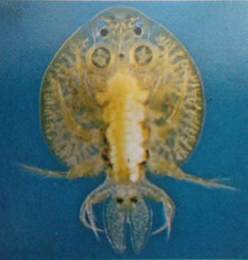
Fully grown they are 3-4mm round and translucent. This makes them quite hard to see as they fasten themselves flat against the body of their host. The female (shown) is slightly larger than the male.
A heavy infestation can weaken a goldfish from blood loss to the point where it will die.
Signs of infestation are when fish are seen rubbing themselves vigorously against any available object in the pond or aquarium. This behavior often causes injury to scales and fins and is more dangerous to the fish than the lice themselves.
Goldfish Lice Sources
Infested fish introduced into the pond or aquarium is an obvious source, but plants gathered from the wild that haven’t been sterilized are often the culprit.
Treatment Options
Dipterex (Dylox neguvon) is effective in combating lice.
It is an insecticide that is soluble in water, comes in liquid or powder form and comes in different potencies ranging from 40 to 98%.
Try and find Dipterex with 98% potency as the doses below are based on this potency level. If you can only find lower potency levels, you will have to calculate how much you need based on the doses below.
The treatments for pond and aquarium are different, but the dosage is the same for each. Below are several measurement options:
Dipterex Dosage
- 1 part Dipterex to 3-5 million parts water or
- 1 milliliter to 660 -1100 Imp gallons of water or
- 1 milliliter to 790 – 1320 US gallons of water.
Be accurate with measuring the dose because above 1.60 ppm Dipterex is acutely toxic to fish. For freshwater invertebrates it is toxic in ppb (parts per billion) so dose on the low side rather than the high.
Pond Treatment
Treat the pond three times at 7 day intervals.
There should be some form of water circulation to spread the Dipterex evenly throughout the pond.
Dipterex isn’t stable in water and breaks down after a few days. The lice eggs survive the treatment but emerging parasites are killed by the follow-up treatments.
Aquarium Treatment
In an aquarium, the lice normally drop off the goldfish within two hours. After this happens, move the fish into a mild salt bath of two teaspoons per gallon of non-iodized salt for a couple of days.
Another treatment option available, especially if the infestation is only one or two lice, is dabbing the louse with a cotton bud that has been dipped in a 50/50 solution of Kerosene and Turpentine. Be careful not to get any of the solution into the gills, mouth or eyes of the fish.
The louse may still need to be removed with tweezers.
Sterilize the aquarium completely (including plants) to kill any adults or nauplii.
A safer more convenient treatment is to use something like Ecological Labs LAWP16 Microbe Lift Lice and Anchor Worm treatment.
As stated on the bottle, this medication will also treat anchor worm which is a convenient bonus but not surprising as both are crustaceans.
Follow the manufacturer’s instructions and monitor your goldfish carefully for signs of toxic reaction such as lethargy, gasping at the surface or turning on its side.
How to Hatch Brine Shrimp Eggs

Instructions and Guidelines
Storing Brine Shrimp Eggs
Brine shrimp eggs should to be stored as follows:
- free from moisture; and
- in a cool environment at or below 50°F.
Hatching Environment
Follow these guidelines for the best results:
- Salinity:
Approximately 11/2 tablespoons of salt per quart (or liter) of water. This equates to about 1.018 specific gravity as measured with a hydrometer. Aquarium, sea or non-iodized table salt can be used. - pH:
Proper pH is important in hatching brine shrimp. A starting pH of 8.0 or higher is recommended. If the pH of your water is below 7, Epson salt or baking soda can be added at the rate of 1/2 teaspoon per quart. - Temperature:
Optimum water temperature for a 24-hour complete hatch is 80-82°F. Lower temperature will result in a longer hatching time, but do not exceed 86°F. - Light:
Illumination can be added to get the best hatching rate, but is not absolutely critical. - Aeration:
Constant aeration is necessary to keep cysts in suspension and to provide sufficient oxygen levels for the cysts to hatch. A nice steady stream of aeration that tumbles the eggs without pushing them above the water surface and onto the side of the hatching cone.
- Stocking Density:
1 gram per liter or quart or approximately 1/2 level teaspoon of cysts per quart is recommended. A higher stocking density will result in a lower hatch percentage. - Hatching Cone:
Flat-bottom hatching vessels should be avoided. Cone or “V” bottomed containers are best to insure that the cysts remain in suspension during hatching. Be sure to thoroughly wash the hatching cone with a light chlorine solution, rinse, and allow to air-dry between uses.
Hatching Procedure
The following steps will achieve optimum brine shrimp egg hatch rates.
Set Up:
Place hatching cone or similarly shaped vessel in well-lit area. Cone should be semi-translucent for ease of harvesting and light transmission.
Add Water:
Fill cone with one liter of water and add 11/2 tablespoons of salt. Optimum hatching temperature is 82°F (28°C).
Add Cysts:
Add cysts at the rate of 1 gram per liter or quart or approximately 1/2 level teaspoon of cysts per quart is recommended. A higher stocking density will result in a lower hatch percentage.
Aerate:
Provide adequate aeration to keep cysts in suspension.
Hatch:
Depending upon water temperature, cysts should hatch in approximately 18-36 hours.
Harvest:
After hatching brine shrimp, turn off or remove aeration and wait several minutes for the shells and and baby brine shrimp (or nauplii) to separate. Newly hatched nauplii will settle to the bottom of the cone or move towards a light source; the shells will float to the surface. The egg shells are brown in color and the baby brine shrimp are more orange. Once separated, the nauplii can be siphoned from the bottom with a length of air tubing or gently drained through the bottom of the cone through a valve, if so equipped.
Rinse:
The warm incubation temperatures and metabolites from the hatching medium create ideal conditions for a bacteria bloom. Rinsing of the baby brine shrimp in a fine mesh net or sieve using clean fresh or salt water is important before feeding them to your fish.
Clean Equipment:
Tanks and brine shrimp hatching equipment should be cleaned and disinfected routinely.
What are the guidelines for Artemia cysts?
Salinity – 20 – 30 parts per thousand (ppt) salt solution or approximately 1-2 tablespoons of rock salt per quart (or liter) of water. This equates to around 1.015-1.020 specific gravity. A 20% (or around 1/2 teaspoon per quart) concentration of Epson salt or magnesium sulfate can be added to further buffer the hatching solution. Temperature – Optimum temperature for a 24 hour complete hatch 26-28° C. Lowering the temperature would result in a longer hatching time. Do not exceed 30°C. Light – Illumination is necessary to trigger the hatching mechanism within the embryo within the first few hours of incubation. Maintaining a light source during the entire incubation period is recommended to obtain optimum hatch results and for temperature control. Aeration – Constant aeration is also necessary to provide sufficient oxygen levels for the cysts to metabolize and hatch. A minimum of 3 parts per million dissolved oxygen during the incubation is recommended. Strong aeration will not damage or hurt the brine shrimp cysts or nauplii. pH – A starting pH of 8.0 or higher is recommended. If pH drops below 7.5 during incubation, add a teaspoon of sodium bicarbonate or a pH buffer to raise it above 8.0. Stocking Density – 2 grams per quart or approximately one level teaspoon of cysts per quart is recommended. A higher stocking density will result in a lower % hatch. Hatching Cone – Flat bottom hatching vessels should be avoided. Cone or “V” bottomed containers are best to insure that the cysts remain in suspension during hatching. Be sure to thoroughly wash the hatching cone with soap and water and allow to air dry between uses.
How do I harvest the baby brine shrimp?
To harvest the baby brine shrimp or nauplii, simply shut off the air and wait a few minutes for the shells and nauplii to separate. The shells will float to the surface and the live nauplii will go to the bottom of the cone towards the light source. Once separated, the nauplii can be siphoned from the bottom or drained from the bottom of the cone through the air tubing.


